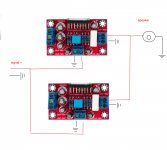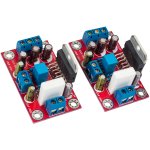I know its possible to parallell a 7293 via slave connection, but I have two 7293 mono boards that I want to parallel without using slave method. Any reason the 94s and 93s cant be parallelled by simply tying the outputs and adding a 5W 0.1ohm resistor at the outs the way we do with the LM3886?
0.1ohm would be rather too low a value, I'd suggest 0.22ohm as a minimum. You'll need to match the gains very closely (like considerably better than 0.1dB) in order to prevent the amps fighting. Also if the gain networks are AC coupled then watch out for the roll-off in the bass - this would need to match too.
0.1ohm would be rather too low a value, I'd suggest 0.22ohm as a minimum. You'll need to match the gains very closely (like considerably better than 0.1dB) in order to prevent the amps fighting. Also if the gain networks are AC coupled then watch out for the roll-off in the bass - this would need to match too.
How do you match the gains? What is the difference in parallelling the 7294 vs the LM3886?
Gains can either be matched by using close tolerance resistors (0.1%) or hand matching 1% resistors with a digital multimeter. I've paralleled TDA7294 myself (if I recall correctly at least 4 in parallel, I used inductors though rather than resistors for sharing), I've not tried with LM3886 though I have with its close relative the LM1876 (also using 4 in parallel).
i hazard even 0.1% resistors would need hand matching to some degree, i tend to use trimmers and set them when they are in circuit. gives an advatage of being able to measure and set when its allready soldered in place.
allso the resistor on the output may be even more than 0.22 ohm. 0.5 ohm is mostly what i used as i tend to find it safer.
for the coupling capaitors i tend to use shared ones, thatway bass rolloff will be closely matched too.
the mroe you want to parallell the more rpecision it takes.
i'm not sure i would parallel 4 of them, the chips them self may have soe differences, i would measure them one by one and adjust them tobe extreemly identical before attempting this at all. then measure them as pairs and fiddle till they are as identical as possible .
allso the resistor on the output may be even more than 0.22 ohm. 0.5 ohm is mostly what i used as i tend to find it safer.
for the coupling capaitors i tend to use shared ones, thatway bass rolloff will be closely matched too.
the mroe you want to parallell the more rpecision it takes.
i'm not sure i would parallel 4 of them, the chips them self may have soe differences, i would measure them one by one and adjust them tobe extreemly identical before attempting this at all. then measure them as pairs and fiddle till they are as identical as possible .
Gains can either be matched by using close tolerance resistors (0.1%) or hand matching 1% resistors with a digital multimeter. I've paralleled TDA7294 myself (if I recall correctly at least 4 in parallel, I used inductors though rather than resistors for sharing), I've not tried with LM3886 though I have with its close relative the LM1876 (also using 4 in parallel).
Im a bit confused on if you are talking about gain matching the input or gain matching the output, can you tell me which resistors in particular should be matched? Should anything be added to the input?
You're not the only one confused here 🙂
I don't get this 'input' and 'output' distinction you're making. The gain of an amp is defined as its output divided by its input. You need to match any resistors which have an effect on the gain no matter where they are in the circuit. This means feedback resistor (output to -ve input) and its gain setting partner (-ve input to 0V). Output sharing resistors do not need to be matched as the amp's gain is not a strong function of their precise value.
I don't get this 'input' and 'output' distinction you're making. The gain of an amp is defined as its output divided by its input. You need to match any resistors which have an effect on the gain no matter where they are in the circuit. This means feedback resistor (output to -ve input) and its gain setting partner (-ve input to 0V). Output sharing resistors do not need to be matched as the amp's gain is not a strong function of their precise value.
You're not the only one confused here 🙂
I don't get this 'input' and 'output' distinction you're making. The gain of an amp is defined as its output divided by its input. You need to match any resistors which have an effect on the gain no matter where they are in the circuit. This means feedback resistor (output to -ve input) and its gain setting partner (-ve input to 0V). Output sharing resistors do not need to be matched as the amp's gain is not a strong function of their precise value.
🙂
The boards I have are attached. So if I understand you correctly, on these boards, I want to make sure the resistors are matched as closely as possible...Is the diagram I made missing anything besides the output .2ohm resistors at the Speaker Out terminals? Should I add any caps or resistors to the signal Input?
Thanks
Attachments
With those boards you don't need to match all the resistors - only two (probably) are gain determining resistors. But you will need to match one of the capacitors (harder than matching resistors) or increase their value by a factor of 10 or more.
If you have a continuity checker the resistors that need matching will be connected to pin2 of the TDA7293. Or perhaps to pin2 via the cap (in the case of the resistor to 0V) and its that cap which needs either matching or increasing in value.
If you have a continuity checker the resistors that need matching will be connected to pin2 of the TDA7293. Or perhaps to pin2 via the cap (in the case of the resistor to 0V) and its that cap which needs either matching or increasing in value.
- Status
- Not open for further replies.
- Home
- Amplifiers
- Chip Amps
- TDA7293/4 Parallel W/o Slaving

